Impact of Management Control Systems on Capabilities and Performance
VerifiedAdded on 2023/01/06
|44
|12242
|36
Report
AI Summary
This report investigates the impact of Management Control Systems (MCS) on organizational performance and capabilities under perceived environmental uncertainty (PEU). It explores the positive relationship between MCS and organizational performance, considering factors like strategic decision-making and environmental dynamics. The study, conducted for a Master of Business Administration program at Liverpool University, examines the effects of MCS in uncertain situations, highlighting the influence of PEU on the relationship between MCS and organizational capabilities and performance. The research utilizes both primary and secondary data collection methods, including interviews, to analyze the impact of MCS on management decisions, organizational capabilities, and performance, and to address the research question: "What is the impact of MCS upon organizational performance?" The study aims to identify how PEU influences the relationship between MCS and organizational outcomes, providing insights into how management teams perceive uncertain business environments and make decisions accordingly.
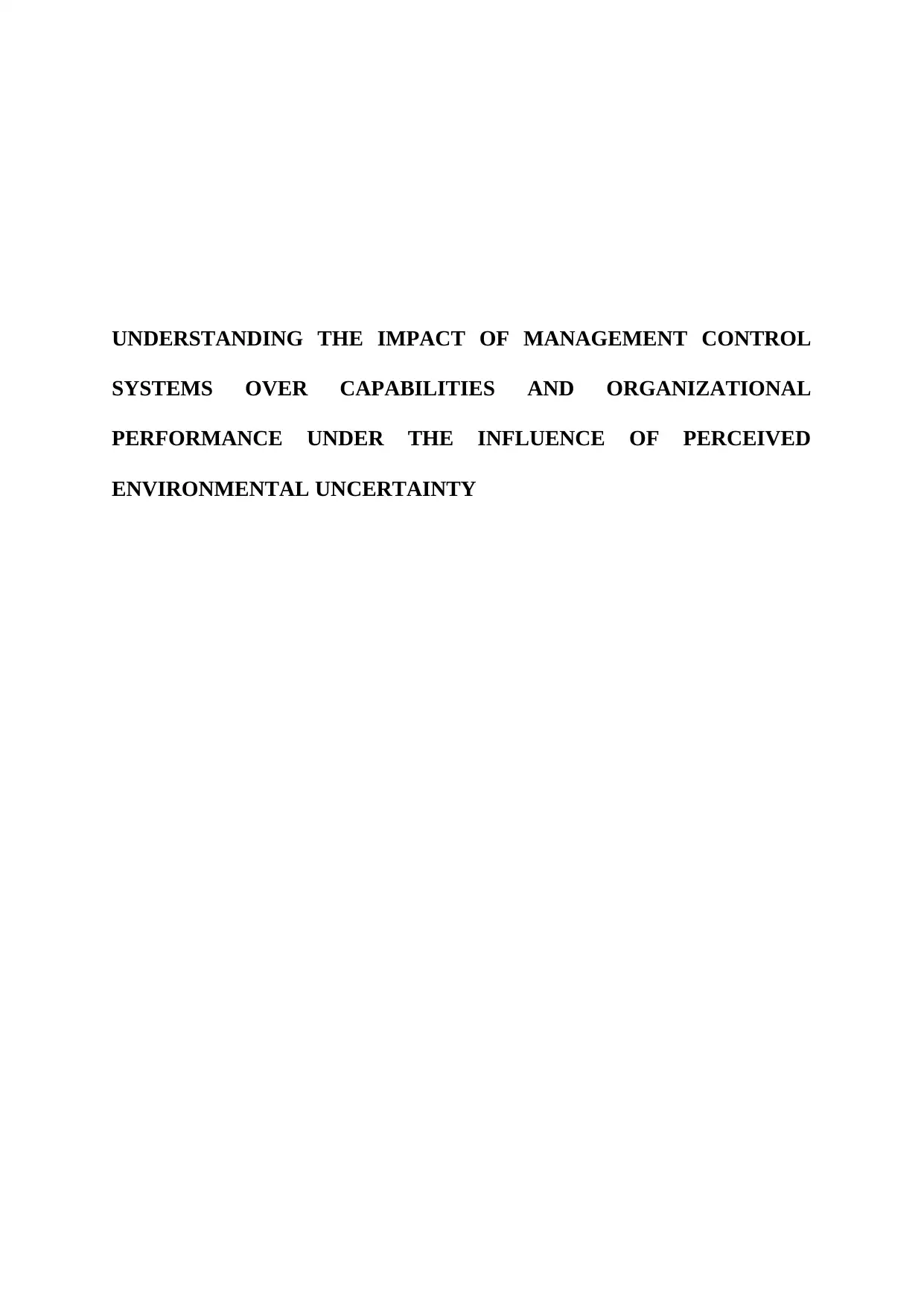
UNDERSTANDING THE IMPACT OF MANAGEMENT CONTROL
SYSTEMS OVER CAPABILITIES AND ORGANIZATIONAL
PERFORMANCE UNDER THE INFLUENCE OF PERCEIVED
ENVIRONMENTAL UNCERTAINTY
SYSTEMS OVER CAPABILITIES AND ORGANIZATIONAL
PERFORMANCE UNDER THE INFLUENCE OF PERCEIVED
ENVIRONMENTAL UNCERTAINTY
Paraphrase This Document
Need a fresh take? Get an instant paraphrase of this document with our AI Paraphraser
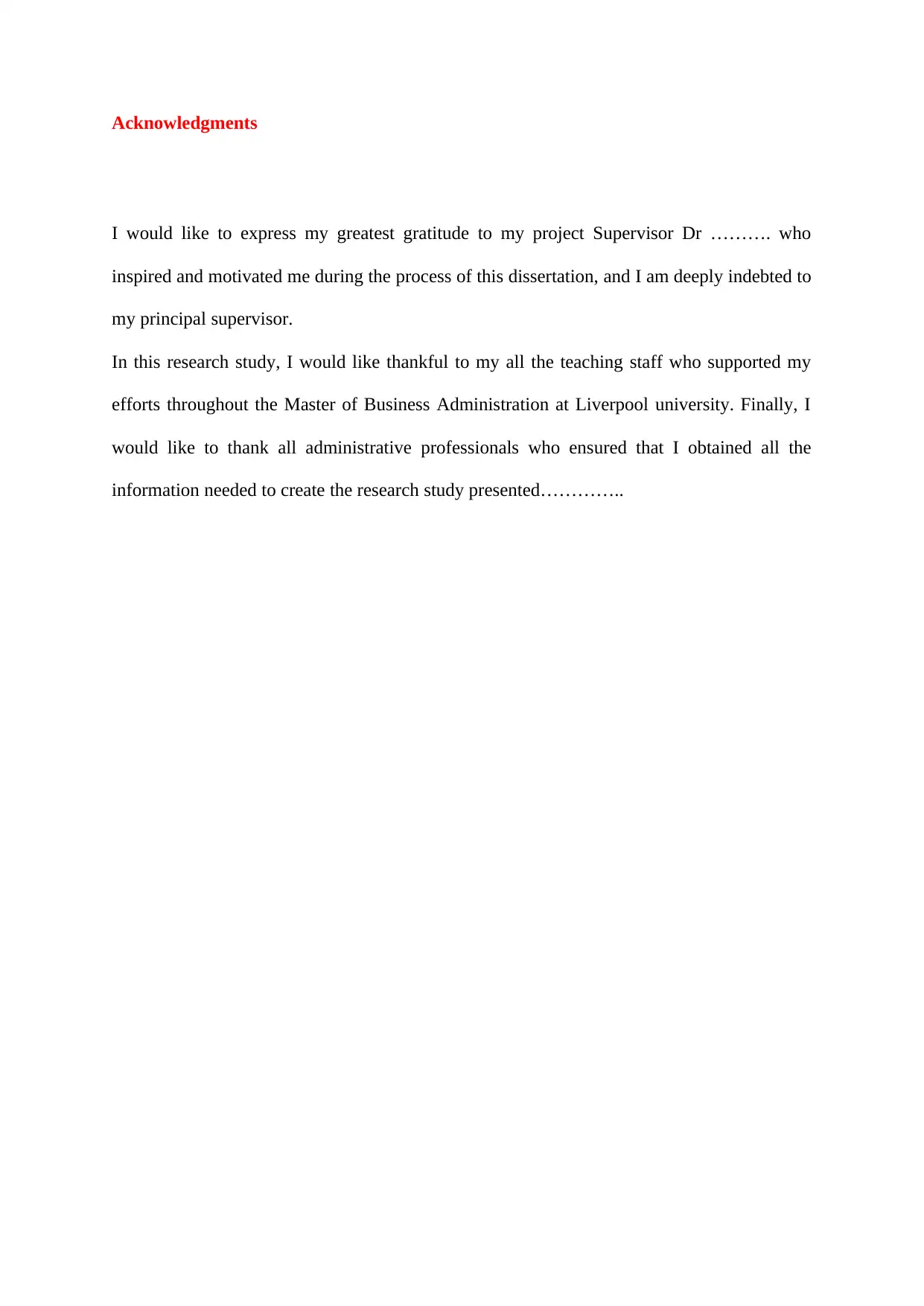
Acknowledgments
I would like to express my greatest gratitude to my project Supervisor Dr ………. who
inspired and motivated me during the process of this dissertation, and I am deeply indebted to
my principal supervisor.
In this research study, I would like thankful to my all the teaching staff who supported my
efforts throughout the Master of Business Administration at Liverpool university. Finally, I
would like to thank all administrative professionals who ensured that I obtained all the
information needed to create the research study presented…………..
I would like to express my greatest gratitude to my project Supervisor Dr ………. who
inspired and motivated me during the process of this dissertation, and I am deeply indebted to
my principal supervisor.
In this research study, I would like thankful to my all the teaching staff who supported my
efforts throughout the Master of Business Administration at Liverpool university. Finally, I
would like to thank all administrative professionals who ensured that I obtained all the
information needed to create the research study presented…………..
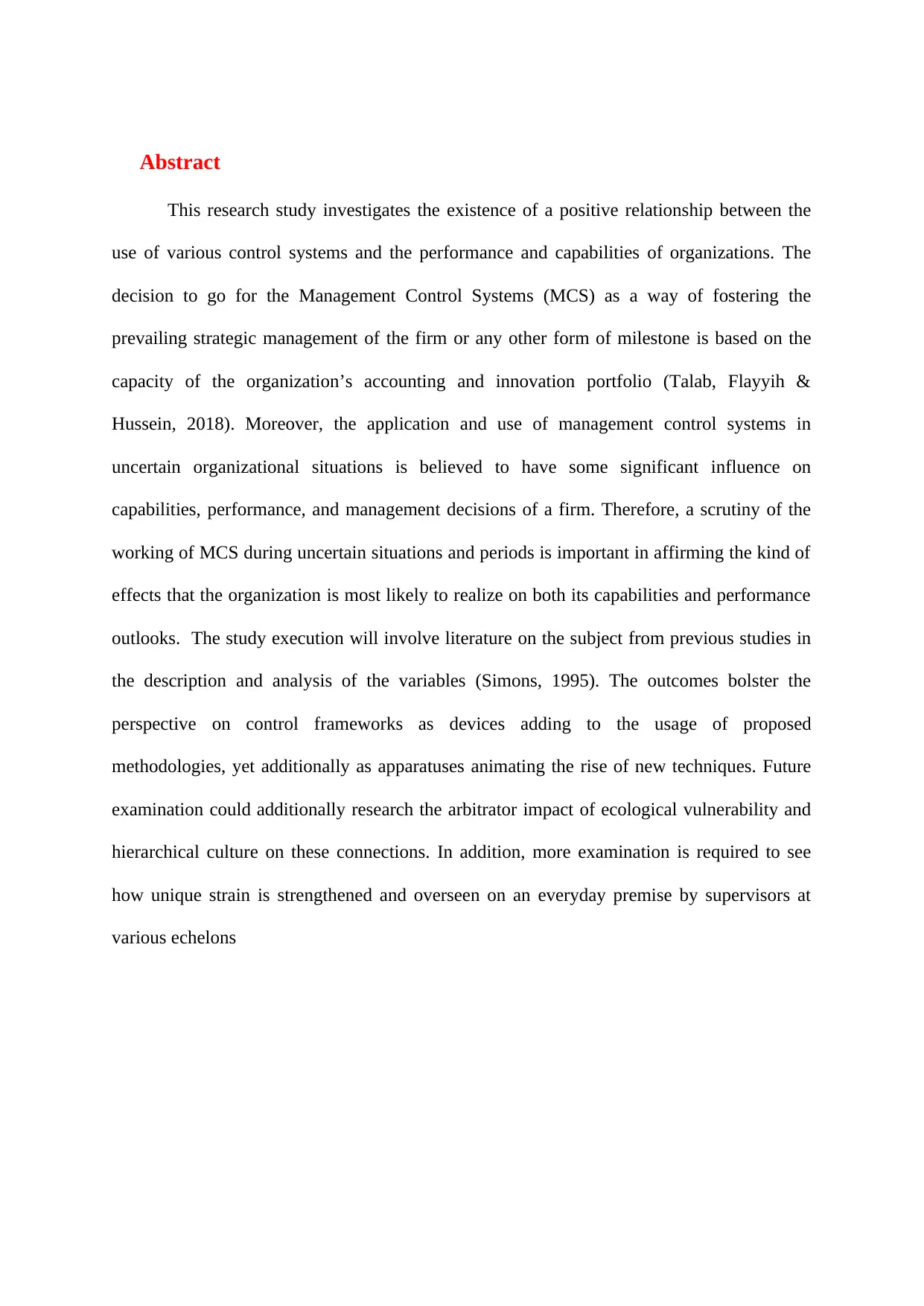
Abstract
This research study investigates the existence of a positive relationship between the
use of various control systems and the performance and capabilities of organizations. The
decision to go for the Management Control Systems (MCS) as a way of fostering the
prevailing strategic management of the firm or any other form of milestone is based on the
capacity of the organization’s accounting and innovation portfolio (Talab, Flayyih &
Hussein, 2018). Moreover, the application and use of management control systems in
uncertain organizational situations is believed to have some significant influence on
capabilities, performance, and management decisions of a firm. Therefore, a scrutiny of the
working of MCS during uncertain situations and periods is important in affirming the kind of
effects that the organization is most likely to realize on both its capabilities and performance
outlooks. The study execution will involve literature on the subject from previous studies in
the description and analysis of the variables (Simons, 1995). The outcomes bolster the
perspective on control frameworks as devices adding to the usage of proposed
methodologies, yet additionally as apparatuses animating the rise of new techniques. Future
examination could additionally research the arbitrator impact of ecological vulnerability and
hierarchical culture on these connections. In addition, more examination is required to see
how unique strain is strengthened and overseen on an everyday premise by supervisors at
various echelons
This research study investigates the existence of a positive relationship between the
use of various control systems and the performance and capabilities of organizations. The
decision to go for the Management Control Systems (MCS) as a way of fostering the
prevailing strategic management of the firm or any other form of milestone is based on the
capacity of the organization’s accounting and innovation portfolio (Talab, Flayyih &
Hussein, 2018). Moreover, the application and use of management control systems in
uncertain organizational situations is believed to have some significant influence on
capabilities, performance, and management decisions of a firm. Therefore, a scrutiny of the
working of MCS during uncertain situations and periods is important in affirming the kind of
effects that the organization is most likely to realize on both its capabilities and performance
outlooks. The study execution will involve literature on the subject from previous studies in
the description and analysis of the variables (Simons, 1995). The outcomes bolster the
perspective on control frameworks as devices adding to the usage of proposed
methodologies, yet additionally as apparatuses animating the rise of new techniques. Future
examination could additionally research the arbitrator impact of ecological vulnerability and
hierarchical culture on these connections. In addition, more examination is required to see
how unique strain is strengthened and overseen on an everyday premise by supervisors at
various echelons
⊘ This is a preview!⊘
Do you want full access?
Subscribe today to unlock all pages.

Trusted by 1+ million students worldwide
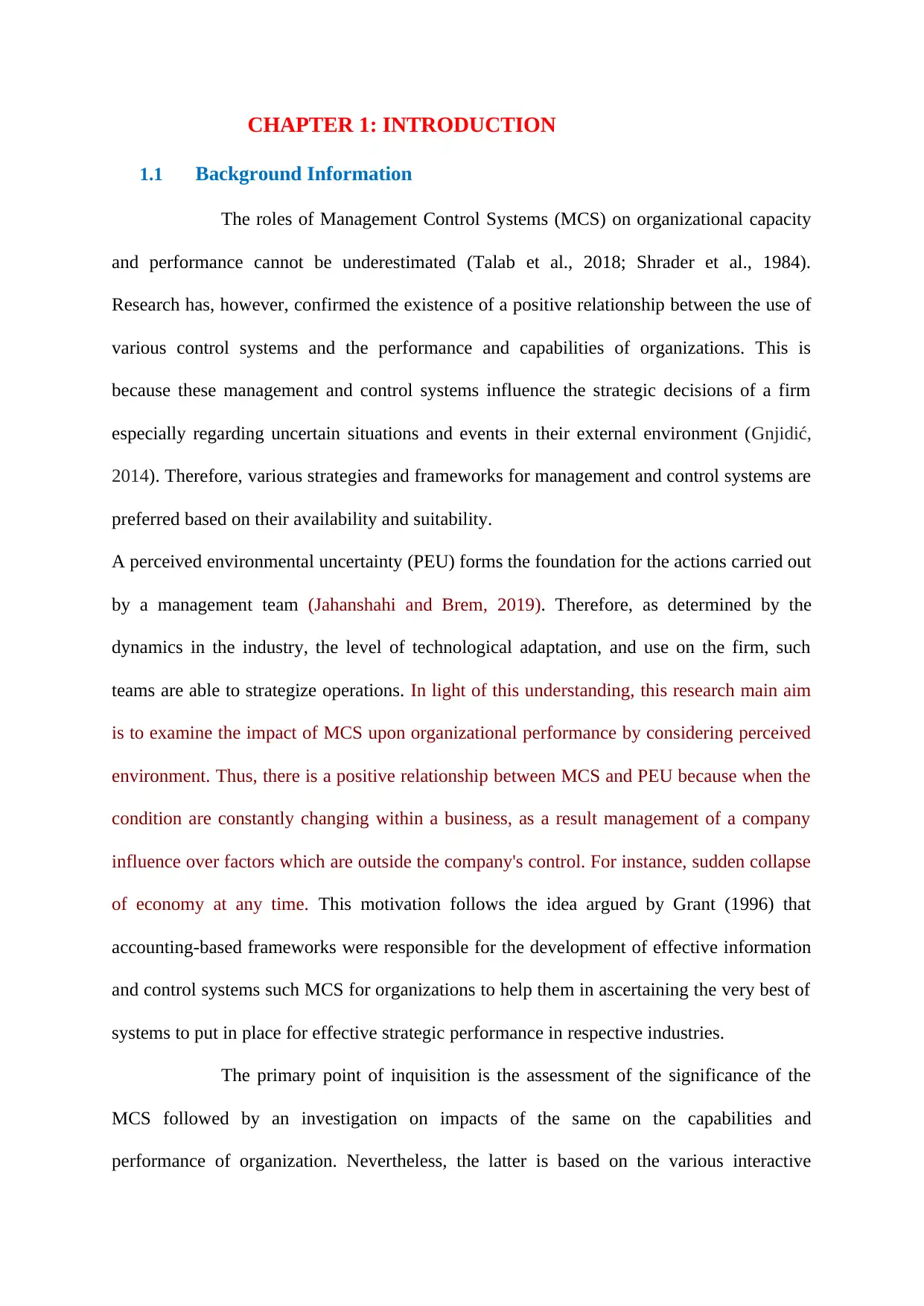
CHAPTER 1: INTRODUCTION
1.1 Background Information
The roles of Management Control Systems (MCS) on organizational capacity
and performance cannot be underestimated (Talab et al., 2018; Shrader et al., 1984).
Research has, however, confirmed the existence of a positive relationship between the use of
various control systems and the performance and capabilities of organizations. This is
because these management and control systems influence the strategic decisions of a firm
especially regarding uncertain situations and events in their external environment (Gnjidić,
2014). Therefore, various strategies and frameworks for management and control systems are
preferred based on their availability and suitability.
A perceived environmental uncertainty (PEU) forms the foundation for the actions carried out
by a management team (Jahanshahi and Brem, 2019). Therefore, as determined by the
dynamics in the industry, the level of technological adaptation, and use on the firm, such
teams are able to strategize operations. In light of this understanding, this research main aim
is to examine the impact of MCS upon organizational performance by considering perceived
environment. Thus, there is a positive relationship between MCS and PEU because when the
condition are constantly changing within a business, as a result management of a company
influence over factors which are outside the company's control. For instance, sudden collapse
of economy at any time. This motivation follows the idea argued by Grant (1996) that
accounting-based frameworks were responsible for the development of effective information
and control systems such MCS for organizations to help them in ascertaining the very best of
systems to put in place for effective strategic performance in respective industries.
The primary point of inquisition is the assessment of the significance of the
MCS followed by an investigation on impacts of the same on the capabilities and
performance of organization. Nevertheless, the latter is based on the various interactive
1.1 Background Information
The roles of Management Control Systems (MCS) on organizational capacity
and performance cannot be underestimated (Talab et al., 2018; Shrader et al., 1984).
Research has, however, confirmed the existence of a positive relationship between the use of
various control systems and the performance and capabilities of organizations. This is
because these management and control systems influence the strategic decisions of a firm
especially regarding uncertain situations and events in their external environment (Gnjidić,
2014). Therefore, various strategies and frameworks for management and control systems are
preferred based on their availability and suitability.
A perceived environmental uncertainty (PEU) forms the foundation for the actions carried out
by a management team (Jahanshahi and Brem, 2019). Therefore, as determined by the
dynamics in the industry, the level of technological adaptation, and use on the firm, such
teams are able to strategize operations. In light of this understanding, this research main aim
is to examine the impact of MCS upon organizational performance by considering perceived
environment. Thus, there is a positive relationship between MCS and PEU because when the
condition are constantly changing within a business, as a result management of a company
influence over factors which are outside the company's control. For instance, sudden collapse
of economy at any time. This motivation follows the idea argued by Grant (1996) that
accounting-based frameworks were responsible for the development of effective information
and control systems such MCS for organizations to help them in ascertaining the very best of
systems to put in place for effective strategic performance in respective industries.
The primary point of inquisition is the assessment of the significance of the
MCS followed by an investigation on impacts of the same on the capabilities and
performance of organization. Nevertheless, the latter is based on the various interactive
Paraphrase This Document
Need a fresh take? Get an instant paraphrase of this document with our AI Paraphraser
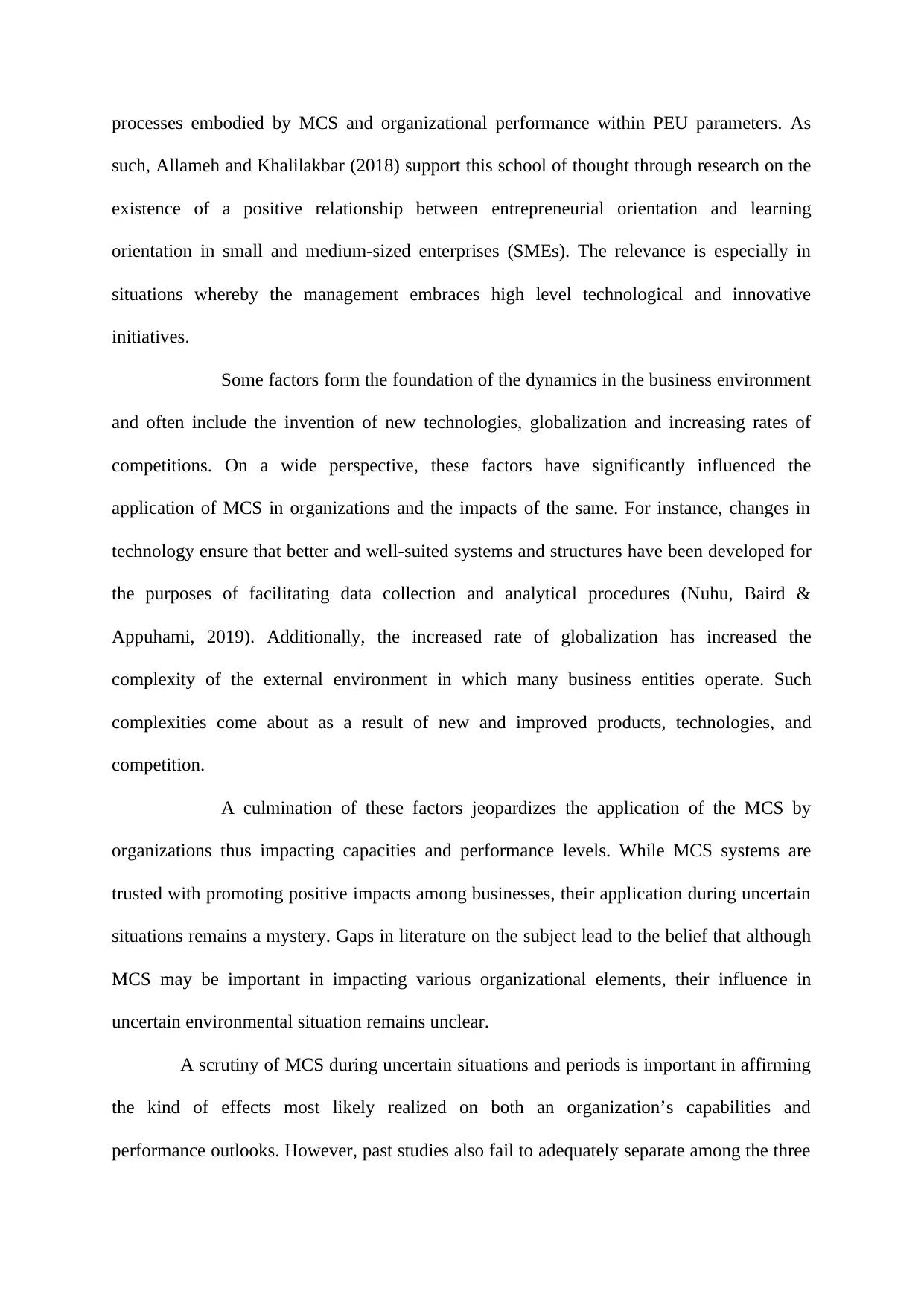
processes embodied by MCS and organizational performance within PEU parameters. As
such, Allameh and Khalilakbar (2018) support this school of thought through research on the
existence of a positive relationship between entrepreneurial orientation and learning
orientation in small and medium-sized enterprises (SMEs). The relevance is especially in
situations whereby the management embraces high level technological and innovative
initiatives.
Some factors form the foundation of the dynamics in the business environment
and often include the invention of new technologies, globalization and increasing rates of
competitions. On a wide perspective, these factors have significantly influenced the
application of MCS in organizations and the impacts of the same. For instance, changes in
technology ensure that better and well-suited systems and structures have been developed for
the purposes of facilitating data collection and analytical procedures (Nuhu, Baird &
Appuhami, 2019). Additionally, the increased rate of globalization has increased the
complexity of the external environment in which many business entities operate. Such
complexities come about as a result of new and improved products, technologies, and
competition.
A culmination of these factors jeopardizes the application of the MCS by
organizations thus impacting capacities and performance levels. While MCS systems are
trusted with promoting positive impacts among businesses, their application during uncertain
situations remains a mystery. Gaps in literature on the subject lead to the belief that although
MCS may be important in impacting various organizational elements, their influence in
uncertain environmental situation remains unclear.
A scrutiny of MCS during uncertain situations and periods is important in affirming
the kind of effects most likely realized on both an organization’s capabilities and
performance outlooks. However, past studies also fail to adequately separate among the three
such, Allameh and Khalilakbar (2018) support this school of thought through research on the
existence of a positive relationship between entrepreneurial orientation and learning
orientation in small and medium-sized enterprises (SMEs). The relevance is especially in
situations whereby the management embraces high level technological and innovative
initiatives.
Some factors form the foundation of the dynamics in the business environment
and often include the invention of new technologies, globalization and increasing rates of
competitions. On a wide perspective, these factors have significantly influenced the
application of MCS in organizations and the impacts of the same. For instance, changes in
technology ensure that better and well-suited systems and structures have been developed for
the purposes of facilitating data collection and analytical procedures (Nuhu, Baird &
Appuhami, 2019). Additionally, the increased rate of globalization has increased the
complexity of the external environment in which many business entities operate. Such
complexities come about as a result of new and improved products, technologies, and
competition.
A culmination of these factors jeopardizes the application of the MCS by
organizations thus impacting capacities and performance levels. While MCS systems are
trusted with promoting positive impacts among businesses, their application during uncertain
situations remains a mystery. Gaps in literature on the subject lead to the belief that although
MCS may be important in impacting various organizational elements, their influence in
uncertain environmental situation remains unclear.
A scrutiny of MCS during uncertain situations and periods is important in affirming
the kind of effects most likely realized on both an organization’s capabilities and
performance outlooks. However, past studies also fail to adequately separate among the three
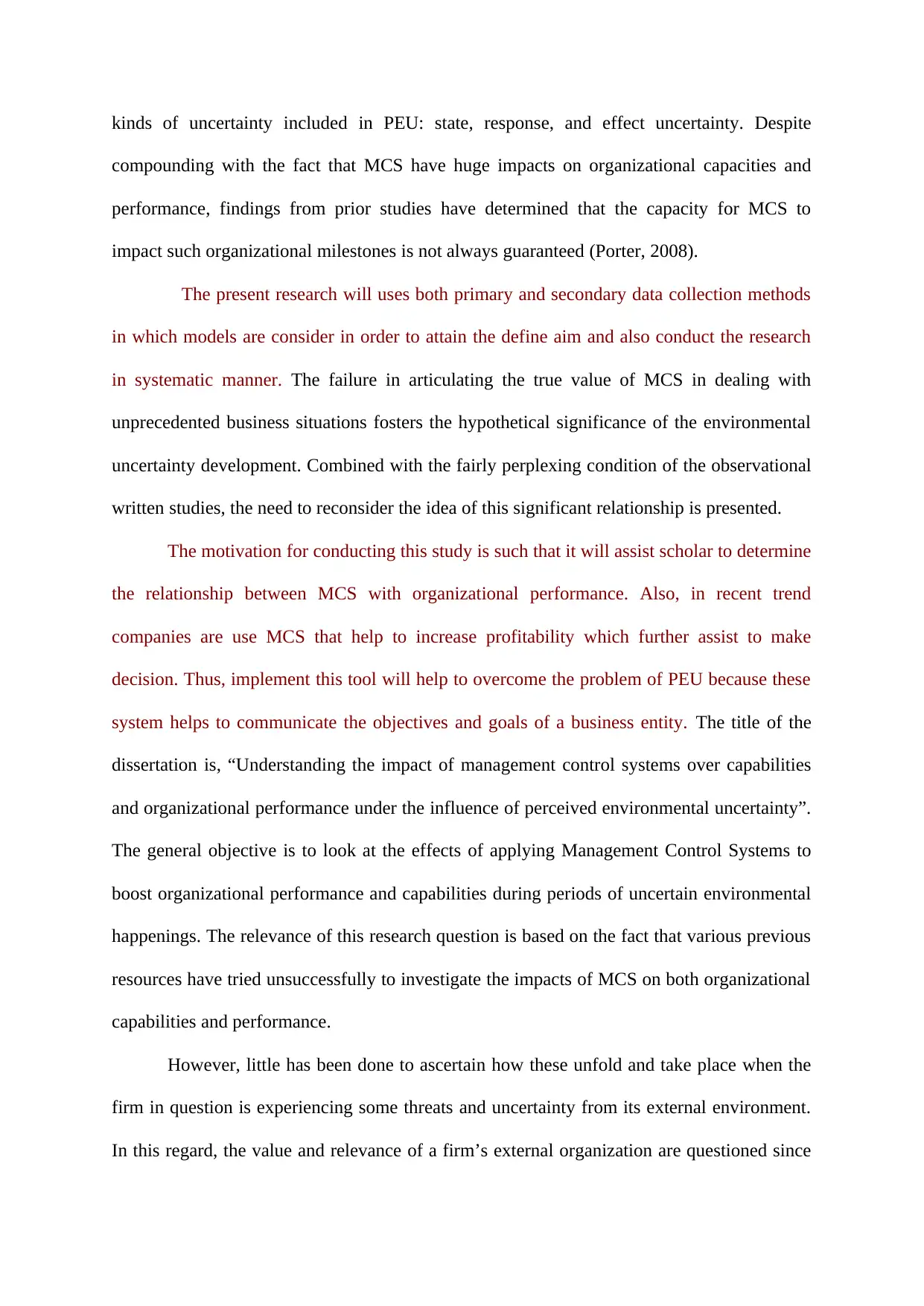
kinds of uncertainty included in PEU: state, response, and effect uncertainty. Despite
compounding with the fact that MCS have huge impacts on organizational capacities and
performance, findings from prior studies have determined that the capacity for MCS to
impact such organizational milestones is not always guaranteed (Porter, 2008).
The present research will uses both primary and secondary data collection methods
in which models are consider in order to attain the define aim and also conduct the research
in systematic manner. The failure in articulating the true value of MCS in dealing with
unprecedented business situations fosters the hypothetical significance of the environmental
uncertainty development. Combined with the fairly perplexing condition of the observational
written studies, the need to reconsider the idea of this significant relationship is presented.
The motivation for conducting this study is such that it will assist scholar to determine
the relationship between MCS with organizational performance. Also, in recent trend
companies are use MCS that help to increase profitability which further assist to make
decision. Thus, implement this tool will help to overcome the problem of PEU because these
system helps to communicate the objectives and goals of a business entity. The title of the
dissertation is, “Understanding the impact of management control systems over capabilities
and organizational performance under the influence of perceived environmental uncertainty”.
The general objective is to look at the effects of applying Management Control Systems to
boost organizational performance and capabilities during periods of uncertain environmental
happenings. The relevance of this research question is based on the fact that various previous
resources have tried unsuccessfully to investigate the impacts of MCS on both organizational
capabilities and performance.
However, little has been done to ascertain how these unfold and take place when the
firm in question is experiencing some threats and uncertainty from its external environment.
In this regard, the value and relevance of a firm’s external organization are questioned since
compounding with the fact that MCS have huge impacts on organizational capacities and
performance, findings from prior studies have determined that the capacity for MCS to
impact such organizational milestones is not always guaranteed (Porter, 2008).
The present research will uses both primary and secondary data collection methods
in which models are consider in order to attain the define aim and also conduct the research
in systematic manner. The failure in articulating the true value of MCS in dealing with
unprecedented business situations fosters the hypothetical significance of the environmental
uncertainty development. Combined with the fairly perplexing condition of the observational
written studies, the need to reconsider the idea of this significant relationship is presented.
The motivation for conducting this study is such that it will assist scholar to determine
the relationship between MCS with organizational performance. Also, in recent trend
companies are use MCS that help to increase profitability which further assist to make
decision. Thus, implement this tool will help to overcome the problem of PEU because these
system helps to communicate the objectives and goals of a business entity. The title of the
dissertation is, “Understanding the impact of management control systems over capabilities
and organizational performance under the influence of perceived environmental uncertainty”.
The general objective is to look at the effects of applying Management Control Systems to
boost organizational performance and capabilities during periods of uncertain environmental
happenings. The relevance of this research question is based on the fact that various previous
resources have tried unsuccessfully to investigate the impacts of MCS on both organizational
capabilities and performance.
However, little has been done to ascertain how these unfold and take place when the
firm in question is experiencing some threats and uncertainty from its external environment.
In this regard, the value and relevance of a firm’s external organization are questioned since
⊘ This is a preview!⊘
Do you want full access?
Subscribe today to unlock all pages.

Trusted by 1+ million students worldwide
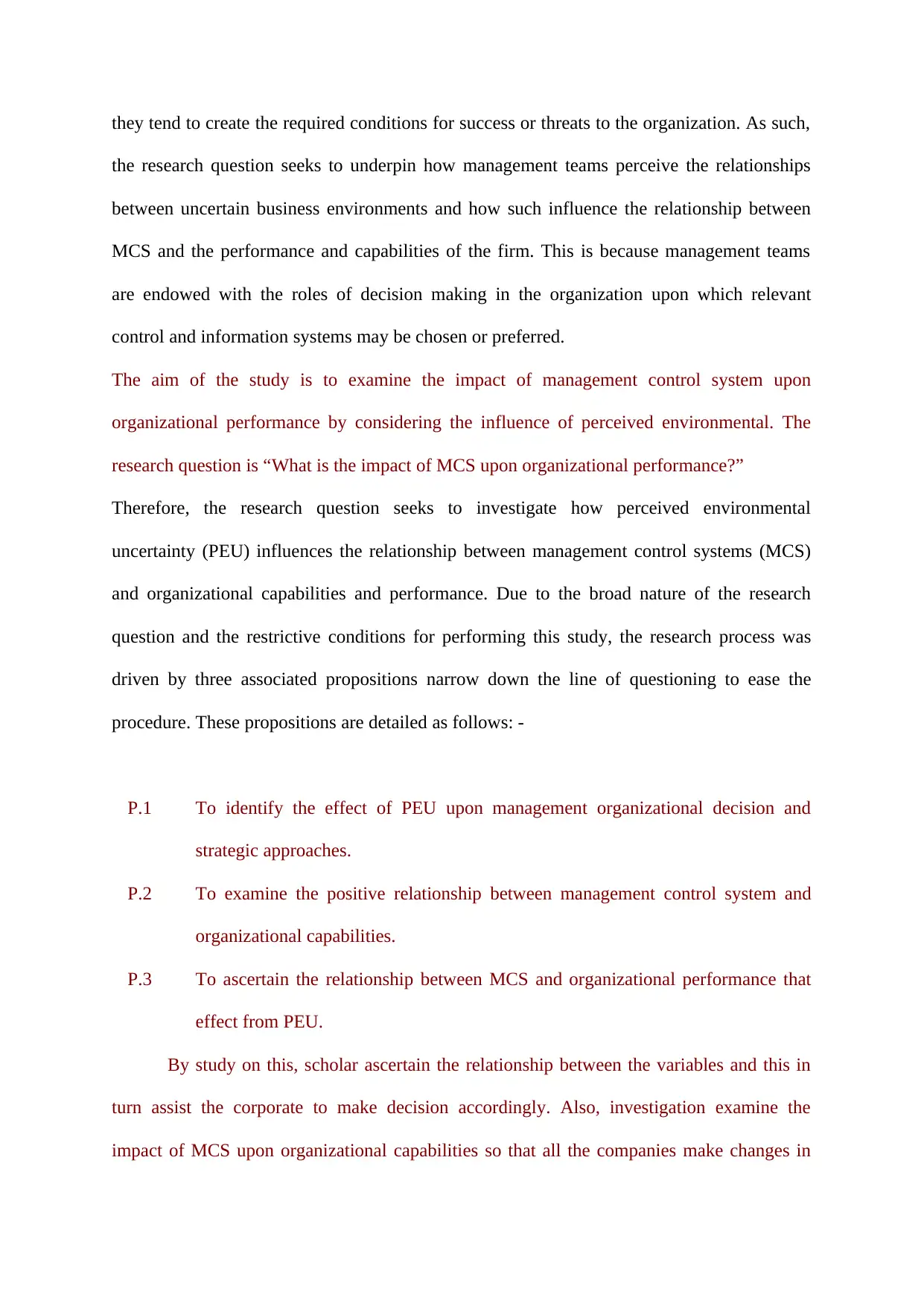
they tend to create the required conditions for success or threats to the organization. As such,
the research question seeks to underpin how management teams perceive the relationships
between uncertain business environments and how such influence the relationship between
MCS and the performance and capabilities of the firm. This is because management teams
are endowed with the roles of decision making in the organization upon which relevant
control and information systems may be chosen or preferred.
The aim of the study is to examine the impact of management control system upon
organizational performance by considering the influence of perceived environmental. The
research question is “What is the impact of MCS upon organizational performance?”
Therefore, the research question seeks to investigate how perceived environmental
uncertainty (PEU) influences the relationship between management control systems (MCS)
and organizational capabilities and performance. Due to the broad nature of the research
question and the restrictive conditions for performing this study, the research process was
driven by three associated propositions narrow down the line of questioning to ease the
procedure. These propositions are detailed as follows: -
P.1 To identify the effect of PEU upon management organizational decision and
strategic approaches.
P.2 To examine the positive relationship between management control system and
organizational capabilities.
P.3 To ascertain the relationship between MCS and organizational performance that
effect from PEU.
By study on this, scholar ascertain the relationship between the variables and this in
turn assist the corporate to make decision accordingly. Also, investigation examine the
impact of MCS upon organizational capabilities so that all the companies make changes in
the research question seeks to underpin how management teams perceive the relationships
between uncertain business environments and how such influence the relationship between
MCS and the performance and capabilities of the firm. This is because management teams
are endowed with the roles of decision making in the organization upon which relevant
control and information systems may be chosen or preferred.
The aim of the study is to examine the impact of management control system upon
organizational performance by considering the influence of perceived environmental. The
research question is “What is the impact of MCS upon organizational performance?”
Therefore, the research question seeks to investigate how perceived environmental
uncertainty (PEU) influences the relationship between management control systems (MCS)
and organizational capabilities and performance. Due to the broad nature of the research
question and the restrictive conditions for performing this study, the research process was
driven by three associated propositions narrow down the line of questioning to ease the
procedure. These propositions are detailed as follows: -
P.1 To identify the effect of PEU upon management organizational decision and
strategic approaches.
P.2 To examine the positive relationship between management control system and
organizational capabilities.
P.3 To ascertain the relationship between MCS and organizational performance that
effect from PEU.
By study on this, scholar ascertain the relationship between the variables and this in
turn assist the corporate to make decision accordingly. Also, investigation examine the
impact of MCS upon organizational capabilities so that all the companies make changes in
Paraphrase This Document
Need a fresh take? Get an instant paraphrase of this document with our AI Paraphraser
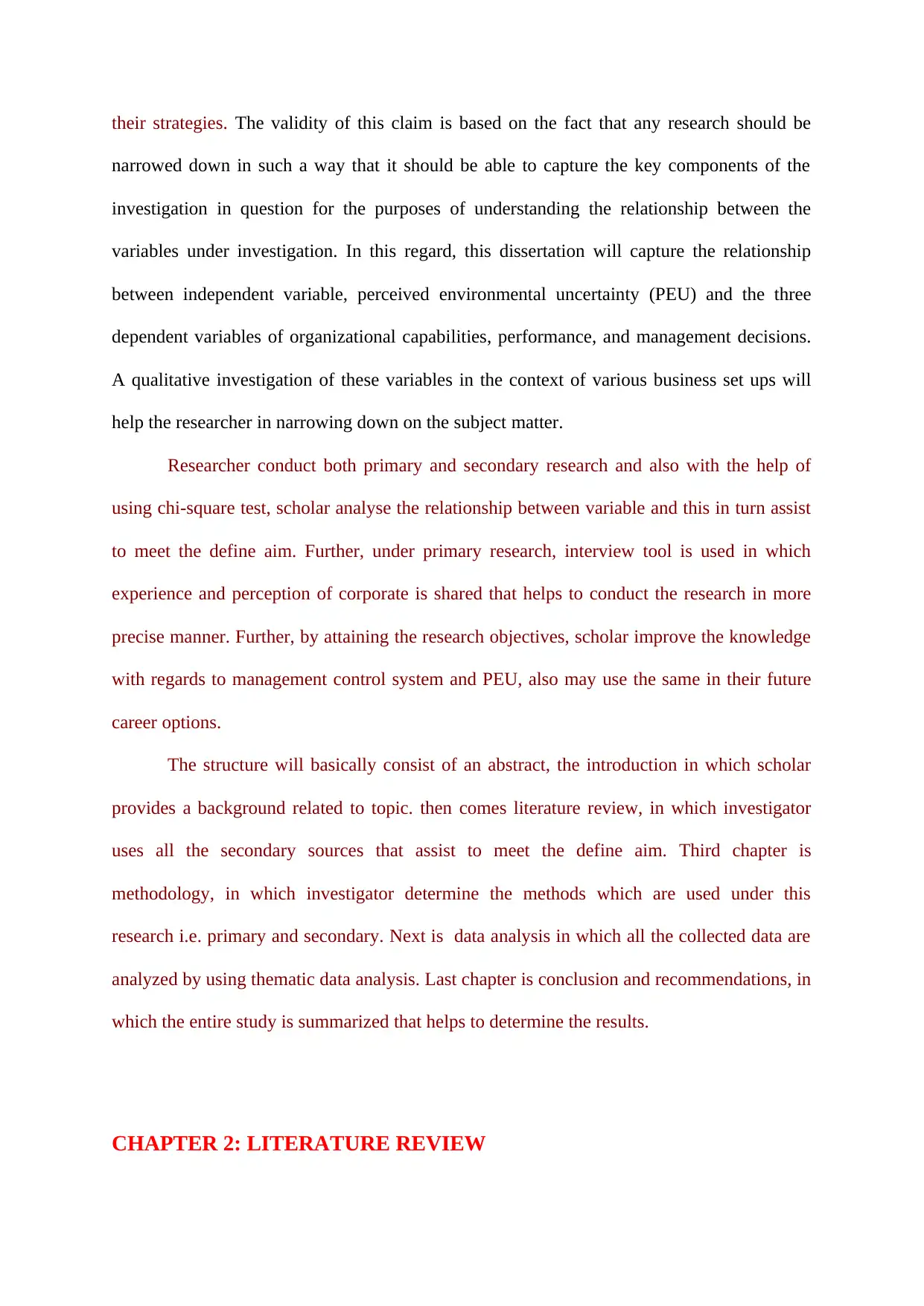
their strategies. The validity of this claim is based on the fact that any research should be
narrowed down in such a way that it should be able to capture the key components of the
investigation in question for the purposes of understanding the relationship between the
variables under investigation. In this regard, this dissertation will capture the relationship
between independent variable, perceived environmental uncertainty (PEU) and the three
dependent variables of organizational capabilities, performance, and management decisions.
A qualitative investigation of these variables in the context of various business set ups will
help the researcher in narrowing down on the subject matter.
Researcher conduct both primary and secondary research and also with the help of
using chi-square test, scholar analyse the relationship between variable and this in turn assist
to meet the define aim. Further, under primary research, interview tool is used in which
experience and perception of corporate is shared that helps to conduct the research in more
precise manner. Further, by attaining the research objectives, scholar improve the knowledge
with regards to management control system and PEU, also may use the same in their future
career options.
The structure will basically consist of an abstract, the introduction in which scholar
provides a background related to topic. then comes literature review, in which investigator
uses all the secondary sources that assist to meet the define aim. Third chapter is
methodology, in which investigator determine the methods which are used under this
research i.e. primary and secondary. Next is data analysis in which all the collected data are
analyzed by using thematic data analysis. Last chapter is conclusion and recommendations, in
which the entire study is summarized that helps to determine the results.
CHAPTER 2: LITERATURE REVIEW
narrowed down in such a way that it should be able to capture the key components of the
investigation in question for the purposes of understanding the relationship between the
variables under investigation. In this regard, this dissertation will capture the relationship
between independent variable, perceived environmental uncertainty (PEU) and the three
dependent variables of organizational capabilities, performance, and management decisions.
A qualitative investigation of these variables in the context of various business set ups will
help the researcher in narrowing down on the subject matter.
Researcher conduct both primary and secondary research and also with the help of
using chi-square test, scholar analyse the relationship between variable and this in turn assist
to meet the define aim. Further, under primary research, interview tool is used in which
experience and perception of corporate is shared that helps to conduct the research in more
precise manner. Further, by attaining the research objectives, scholar improve the knowledge
with regards to management control system and PEU, also may use the same in their future
career options.
The structure will basically consist of an abstract, the introduction in which scholar
provides a background related to topic. then comes literature review, in which investigator
uses all the secondary sources that assist to meet the define aim. Third chapter is
methodology, in which investigator determine the methods which are used under this
research i.e. primary and secondary. Next is data analysis in which all the collected data are
analyzed by using thematic data analysis. Last chapter is conclusion and recommendations, in
which the entire study is summarized that helps to determine the results.
CHAPTER 2: LITERATURE REVIEW

The current section of the study provides a summary of previous research on a topic
in which relevant secondary sources are used that assist to meet the define aim. Literature
review enumerate, describe and evaluate previous study and support the same in present
study (Anderson, 2006).
The perceived environmental uncertainty (PEU) is all about lack o information about
a world around a firm as perceived by decision makers. Therefore, this lack of information is
due to decision related items i.e. difficult to understand and sudden changing in trend. Lee
(2013) detailed that remotely arranged particular abilities at the specialty unit level (statistical
surveying and item improvement) were basic for firms stood up to with high degrees of PEU.
Conversely, creation (an inside arranged action) was basic for firms contending in
circumstances with low PEU. Hitt, Ireland, and Palia (1982) found that PEU influenced the
gathering of corporate-level utilitarian exercises seen as basic to firm execution.
Notwithstanding, they discovered both remotely and inside arranged capacities to be basic for
firms confronted with high PEU, while the best impacts were found for firms with medium
PEU (Gnjidić, 2014).
Proof subsequently proposes that PEU may impact which gathering of unmistakable
capabilities is identified with execution at both the corporate and specialty unit levels. Be that
as it may, the specific determination of these groupings, especially at the corporate level,
stays indistinct. Proof presented by Gnjidić (2014) recommends that administrative activity
depends on a supervisor's view of natural vulnerability. Along these lines, activities intended
to create particular abilities are probably going to differ as indicated by PEU.
Exploration proposes that unmistakable abilities may likewise change with a company's
predominant innovation. For instance, Kim and Shin (2013) detailed that innovative work
exercises were basic for firms that utilized the creation framework dictating the production of
units by supply, while creation exercises were the most significant for firms utilizing a huge
in which relevant secondary sources are used that assist to meet the define aim. Literature
review enumerate, describe and evaluate previous study and support the same in present
study (Anderson, 2006).
The perceived environmental uncertainty (PEU) is all about lack o information about
a world around a firm as perceived by decision makers. Therefore, this lack of information is
due to decision related items i.e. difficult to understand and sudden changing in trend. Lee
(2013) detailed that remotely arranged particular abilities at the specialty unit level (statistical
surveying and item improvement) were basic for firms stood up to with high degrees of PEU.
Conversely, creation (an inside arranged action) was basic for firms contending in
circumstances with low PEU. Hitt, Ireland, and Palia (1982) found that PEU influenced the
gathering of corporate-level utilitarian exercises seen as basic to firm execution.
Notwithstanding, they discovered both remotely and inside arranged capacities to be basic for
firms confronted with high PEU, while the best impacts were found for firms with medium
PEU (Gnjidić, 2014).
Proof subsequently proposes that PEU may impact which gathering of unmistakable
capabilities is identified with execution at both the corporate and specialty unit levels. Be that
as it may, the specific determination of these groupings, especially at the corporate level,
stays indistinct. Proof presented by Gnjidić (2014) recommends that administrative activity
depends on a supervisor's view of natural vulnerability. Along these lines, activities intended
to create particular abilities are probably going to differ as indicated by PEU.
Exploration proposes that unmistakable abilities may likewise change with a company's
predominant innovation. For instance, Kim and Shin (2013) detailed that innovative work
exercises were basic for firms that utilized the creation framework dictating the production of
units by supply, while creation exercises were the most significant for firms utilizing a huge
⊘ This is a preview!⊘
Do you want full access?
Subscribe today to unlock all pages.

Trusted by 1+ million students worldwide

cluster and-large scale manufacturing framework, and showcasing exercises were basic for
those with a ceaseless procedure creation framework. Others such as Thompson (2003) and
Perrow, (2000) propose that utilizing increasingly complex innovations regularly requires the
creation capacity to be a competence.
The concept of Management Control Systems (MCS) denotes the arrangement of
methods and procedures that executives and other high ranking members use so as to help
guarantee the accomplishment of their objectives and the objectives of their companies (Otley
and Berry, 1994), and it envelops formal control frameworks just as casual individual and
social controls. Formal MCS comprise of intentionally planned, data based and express
arrangements of structures, schedules, systems and procedures (Merchant & Van der Stede,
2007; Simons, 1995) that assist administrators with guaranteeing that their organizations
techniques and plans are done or, if conditions warrant, that they are changed (Bisbe &Otley,
2004)
2.1 PEU and Organizational Capabilities
The aim of this study is to primarily look at the relationship between the Management
Control Systems (MCS), over capabilities and performance of an organization in situations of
perceived environmental uncertainty (PEU). On this regard, the dissertation seeks to examine
the dynamic role of organizational capabilities based on the flexibility of strategies, and the
empowerment of employees in it. Therefore, the Management Control Systems (MCS) are
vital in formulation of sustainable competitiveness strategies that enhance better performance
results over capabilities on an organization. According to Govindarajan (1988), MCS have
internal systems and structures such as strategies, and favorable environment that are
incorporated together to set high performance of an organization.
those with a ceaseless procedure creation framework. Others such as Thompson (2003) and
Perrow, (2000) propose that utilizing increasingly complex innovations regularly requires the
creation capacity to be a competence.
The concept of Management Control Systems (MCS) denotes the arrangement of
methods and procedures that executives and other high ranking members use so as to help
guarantee the accomplishment of their objectives and the objectives of their companies (Otley
and Berry, 1994), and it envelops formal control frameworks just as casual individual and
social controls. Formal MCS comprise of intentionally planned, data based and express
arrangements of structures, schedules, systems and procedures (Merchant & Van der Stede,
2007; Simons, 1995) that assist administrators with guaranteeing that their organizations
techniques and plans are done or, if conditions warrant, that they are changed (Bisbe &Otley,
2004)
2.1 PEU and Organizational Capabilities
The aim of this study is to primarily look at the relationship between the Management
Control Systems (MCS), over capabilities and performance of an organization in situations of
perceived environmental uncertainty (PEU). On this regard, the dissertation seeks to examine
the dynamic role of organizational capabilities based on the flexibility of strategies, and the
empowerment of employees in it. Therefore, the Management Control Systems (MCS) are
vital in formulation of sustainable competitiveness strategies that enhance better performance
results over capabilities on an organization. According to Govindarajan (1988), MCS have
internal systems and structures such as strategies, and favorable environment that are
incorporated together to set high performance of an organization.
Paraphrase This Document
Need a fresh take? Get an instant paraphrase of this document with our AI Paraphraser
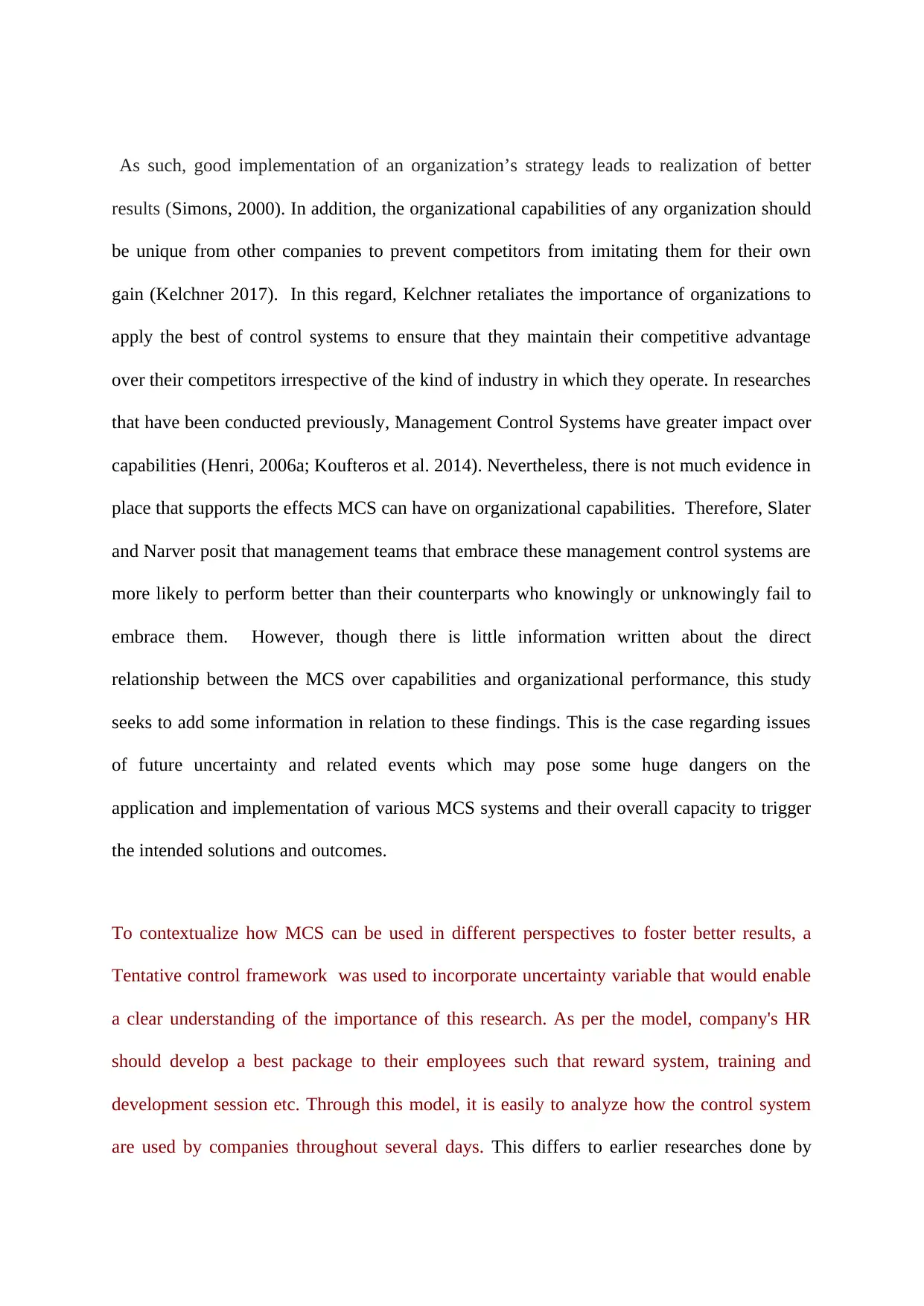
As such, good implementation of an organization’s strategy leads to realization of better
results (Simons, 2000). In addition, the organizational capabilities of any organization should
be unique from other companies to prevent competitors from imitating them for their own
gain (Kelchner 2017). In this regard, Kelchner retaliates the importance of organizations to
apply the best of control systems to ensure that they maintain their competitive advantage
over their competitors irrespective of the kind of industry in which they operate. In researches
that have been conducted previously, Management Control Systems have greater impact over
capabilities (Henri, 2006a; Koufteros et al. 2014). Nevertheless, there is not much evidence in
place that supports the effects MCS can have on organizational capabilities. Therefore, Slater
and Narver posit that management teams that embrace these management control systems are
more likely to perform better than their counterparts who knowingly or unknowingly fail to
embrace them. However, though there is little information written about the direct
relationship between the MCS over capabilities and organizational performance, this study
seeks to add some information in relation to these findings. This is the case regarding issues
of future uncertainty and related events which may pose some huge dangers on the
application and implementation of various MCS systems and their overall capacity to trigger
the intended solutions and outcomes.
To contextualize how MCS can be used in different perspectives to foster better results, a
Tentative control framework was used to incorporate uncertainty variable that would enable
a clear understanding of the importance of this research. As per the model, company's HR
should develop a best package to their employees such that reward system, training and
development session etc. Through this model, it is easily to analyze how the control system
are used by companies throughout several days. This differs to earlier researches done by
results (Simons, 2000). In addition, the organizational capabilities of any organization should
be unique from other companies to prevent competitors from imitating them for their own
gain (Kelchner 2017). In this regard, Kelchner retaliates the importance of organizations to
apply the best of control systems to ensure that they maintain their competitive advantage
over their competitors irrespective of the kind of industry in which they operate. In researches
that have been conducted previously, Management Control Systems have greater impact over
capabilities (Henri, 2006a; Koufteros et al. 2014). Nevertheless, there is not much evidence in
place that supports the effects MCS can have on organizational capabilities. Therefore, Slater
and Narver posit that management teams that embrace these management control systems are
more likely to perform better than their counterparts who knowingly or unknowingly fail to
embrace them. However, though there is little information written about the direct
relationship between the MCS over capabilities and organizational performance, this study
seeks to add some information in relation to these findings. This is the case regarding issues
of future uncertainty and related events which may pose some huge dangers on the
application and implementation of various MCS systems and their overall capacity to trigger
the intended solutions and outcomes.
To contextualize how MCS can be used in different perspectives to foster better results, a
Tentative control framework was used to incorporate uncertainty variable that would enable
a clear understanding of the importance of this research. As per the model, company's HR
should develop a best package to their employees such that reward system, training and
development session etc. Through this model, it is easily to analyze how the control system
are used by companies throughout several days. This differs to earlier researches done by
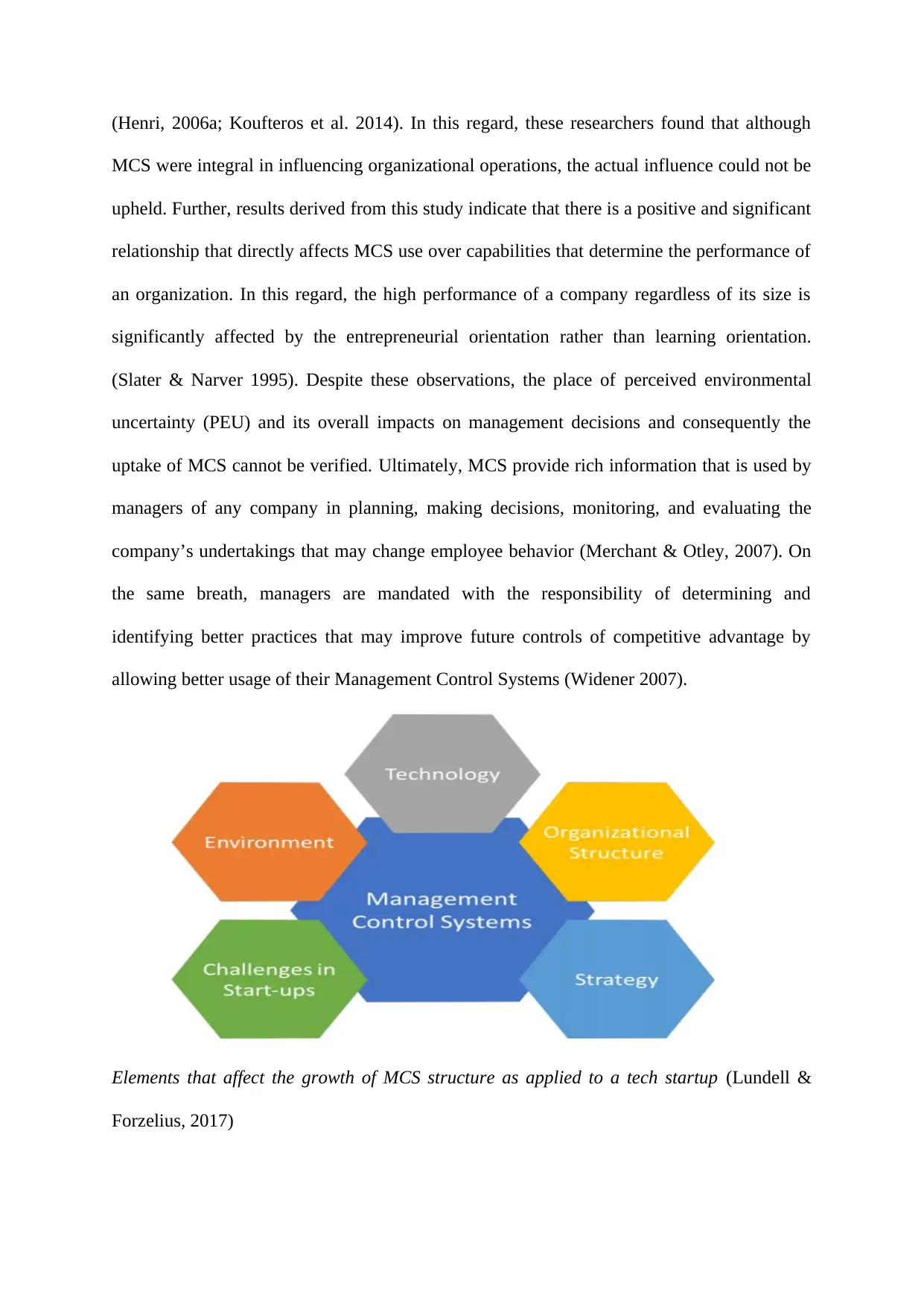
(Henri, 2006a; Koufteros et al. 2014). In this regard, these researchers found that although
MCS were integral in influencing organizational operations, the actual influence could not be
upheld. Further, results derived from this study indicate that there is a positive and significant
relationship that directly affects MCS use over capabilities that determine the performance of
an organization. In this regard, the high performance of a company regardless of its size is
significantly affected by the entrepreneurial orientation rather than learning orientation.
(Slater & Narver 1995). Despite these observations, the place of perceived environmental
uncertainty (PEU) and its overall impacts on management decisions and consequently the
uptake of MCS cannot be verified. Ultimately, MCS provide rich information that is used by
managers of any company in planning, making decisions, monitoring, and evaluating the
company’s undertakings that may change employee behavior (Merchant & Otley, 2007). On
the same breath, managers are mandated with the responsibility of determining and
identifying better practices that may improve future controls of competitive advantage by
allowing better usage of their Management Control Systems (Widener 2007).
Elements that affect the growth of MCS structure as applied to a tech startup (Lundell &
Forzelius, 2017)
MCS were integral in influencing organizational operations, the actual influence could not be
upheld. Further, results derived from this study indicate that there is a positive and significant
relationship that directly affects MCS use over capabilities that determine the performance of
an organization. In this regard, the high performance of a company regardless of its size is
significantly affected by the entrepreneurial orientation rather than learning orientation.
(Slater & Narver 1995). Despite these observations, the place of perceived environmental
uncertainty (PEU) and its overall impacts on management decisions and consequently the
uptake of MCS cannot be verified. Ultimately, MCS provide rich information that is used by
managers of any company in planning, making decisions, monitoring, and evaluating the
company’s undertakings that may change employee behavior (Merchant & Otley, 2007). On
the same breath, managers are mandated with the responsibility of determining and
identifying better practices that may improve future controls of competitive advantage by
allowing better usage of their Management Control Systems (Widener 2007).
Elements that affect the growth of MCS structure as applied to a tech startup (Lundell &
Forzelius, 2017)
⊘ This is a preview!⊘
Do you want full access?
Subscribe today to unlock all pages.

Trusted by 1+ million students worldwide
1 out of 44
Related Documents
Your All-in-One AI-Powered Toolkit for Academic Success.
+13062052269
info@desklib.com
Available 24*7 on WhatsApp / Email
![[object Object]](/_next/static/media/star-bottom.7253800d.svg)
Unlock your academic potential
Copyright © 2020–2025 A2Z Services. All Rights Reserved. Developed and managed by ZUCOL.





